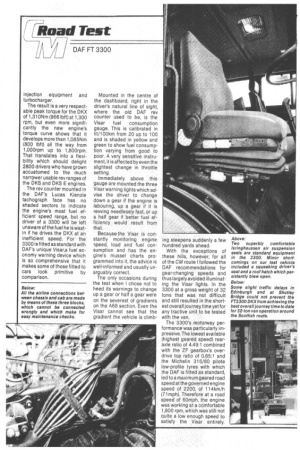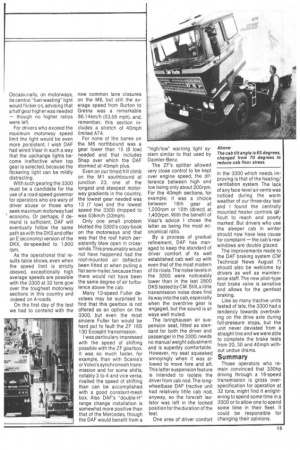Scottish gold for tractive unit
Page 41

Page 42

Page 43

If you've noticed an error in this article please click here to report it so we can fix it.
Tim Blakemore took this 330hp model with 16 ratios round our Scottish route in record time and with a reasonable fuel consumption
THREE HUNDRED and thirty horsepower and 16 transmission ratios for operation at 32 tons gross combination weight? A number of operators regard this as an extravagant and money-wasting over-specification for any vehicle. But in the age of the tachograph and eight-hour driving day, the possibility of losing money through underspecification may well be greater.
It is the general awareness of this among operators and manufacturers that is mainly responsible for the persistent trend towards higher horsepower engines. That and the fact that the latest high-power, high-torque automotive diesels have much improved fuel efficiency to match.
This road test and operational trial of DAF's latest topof-the-range 4x2 tractive unit demonstrates the point admirably. The 3300 went around CM's 737-mile Scottish route in record time and, as the results table shows, that certainly was not at the expense of fuel consumption. The overall average was a creditable 41.18 lit/100km (6.86mpg). Yes, other tractive units have used less fuel in pulling CM's van semi-trailer around the Scottish route, but invariably with significantly longer journey times.
Scania's 305 horsepower R112 (tested in CM December 26, 1981) was the previous fastest at 32 tons with our van over the longhaul route with an average speed of 41.83mph. Its overall average mpg was virtually identical to that of the DAF, in fact, it used just less than one litre more than the Dutch unit.
It is important to be specific about the running weight and the type of trailer pulled when making comparisons of this kind, if the results are to be at all meaningful.
The quest for good comparability led us to decide, when we first began to use the van semi-trailer in February 1981, not to allow roofmounted air deflectors on our tests. This is a policy we have adhered to, and it led to our spending a short time at the beginning of this test removing the deflector which was fitted to the test tractive unit at Eindhoven. It is one of the recent additions to the list of factory-fitted options.
That list now also includes an under-bumper air dam (also fitted to the test vehicle, but permissible). Together and complete with fitting kits, these two dragreducing devices, both made of glass-reinforced plastics, will add about 477 to the retail price of the unit in this country.
The 3300 is fitted with the DKX engine, the latest version of the long-serving 11.6litre DAF unit, introduced earlier this year at the same time as the more extensively modified 81/4-litre DAF engine variants (the OHS range), which power the new 2100, 2300 and 2500 models. The maximum power and to gue of the already turbocharged and charge-cooled 11.6-litre in-line six were boosted by, respectively, 71/2 per cent and 12 per cent compared with the DKS engine (CM group test October 25, 1980) by means of changes to the fuel continued overleaf injection equipment and turbocharger.
The result is a very respectable peak torque for the DKX of 1,310Nm (966 lbft) at 1,300 rpm, but even more significantly the new engine's torque curve shows that it develops more than 1,085Nm (800 lbft) all the way from 1,000rpm up to 1,800rpm. That translates into a flexibility which should delight 2800 drivers who have grown accustomed to the much narrower usable rev ranges of the DKS and DKS E engines.
The rev counter mounted in the DAF's Lucas Kienzle tachograph face has no shaded sectors to indicate the engine's most fuel efficient speed range, but no driver of a 3300 will be left unaware of the fuel he is westin if he drives the DKX at an inefficient speed. For the 3300 is fitted as standard with DAF's unique Visar,a fuel economy warning device which is so comprehensive that it makes some of those fitted to cars look primitive by comparison. Mounted in the centre of the dashboard, right in the driver's natural line of sight, where the old DAF rev counter used to be, is the Visar fuel consumption gauge. This is calibrated in lit/100km from 20 up to 100 and is shaded in yellow and green to show fuel consumption varying from good to poor. A very sensitive instrument, it is affected by even the slightest change in throttle setting.
Immediately above this gauge are mounted the three Visar warning lights which advise the driver to change down a gear if the engine is labouring, up a gear if it is revving needlessly fast, or up a half gear if better fuel efficiency would result from that.
Because the Visar is constantly monitoring engine speed, load and fuel consumption and has the engine's mussel charts programmed into it, the advice is well-informed and usually unarguably correct.
The only occasions during the test when I chose not to heed its warnings to change up a gear or half a gear were on the severest of gradients on the A68 section. Even the Visar cannot see that the gradient the vehicle is climb ing steepens suddenly a few hundred yards ahead.
With the exceptions of these hills, however, for all of the CM route I followed the DAF recommendations for gear-changing speeds and thus largelyavoided illuminating the Visar lights. In the 3300 at a gross weight of 32 tons that was not difficult and still resulted in the shortest overall journey time yet for any tractive unit to be tested with the van.
The 3300's motorway performance was particularly impressive. The lowest available (highest geared speed) rearaxle ratio of 4.49:1 combined with the ZF gearbox's overdrive top ratio of 0.85:1 and the Michelin 315/80 pilote low-profile tyres with which the DAF is fitted as standard, led to a maximum geared road speed at the governed engine speed of 2200, of 114km/h (71 mph). Therefore at a road speed of 60mph, the engine was working at a comfortable 1,800 rpm, which was still not quite a low enough speed to satisfy the .Visar entirely.
Occasionally, on motorways, its central "fuel-wasting" light would flicker on, advising that a half gear higherwas needed — though no higher ratios were left.
For drivers who exceed the maximum motorway speed limit the light would be even more persistent. I wish DAF had wired Visar in such a way that the upchange lights become ineffective when top gear is selected, because the flickering light can be mildly distracting.
With such gearing the 3300 must be a candidate for the use of a road-speed governor for operators who are wary of driver abuse or those who seek maximum motorway fuel economy. Or perhaps, if demand is sufficient, DAF will eventually follow the same path as with the DKS and offer an E (economy) version of the DKX, de-speeded to 1,800 rpm.
As the operational trial results table shows, even when the speed limit is strictly obeyed, exceptionally high average speeds are possible with the 3300 at 32 tons gcw over the toughest motorway sections in this country and indeed on A-roads.
On the first day of the test we had to contend with the now common lane closures on the M6, but still the average speed from Burton to Gretna was a remarkable 86.14km/h (53.58 mph), and, remember, this section includes a stretch of 40mph limited A74.
For none of the banks on the M6 northbound was a gear lower than 15 (8 low) needed and that includes Shap over which the DAF stormed at 45mph plus.
Even on our timed hill climb on the M1 southbound at junction 23, one of the longest and steepest motorway gradients in the country, the lowest gear needed was 13 (7 low) and the lowest speed the 3300 dropped to was 53km/h (33mph).
Only one small problem blotted the 3300's copy-book on the motorways and that was that the roof hatch persistently blew open in crosswinds. This presumably would not have happened had the roof-mounted air deflector been fitted or when pulling a flat semi-trailer, because then there would not have been the same degree of air turbulence above the cab.
Many 13-speed Fuller devotees may be surprised to find that this gearbox is not offered as an option on the 3300, but even the most sincere Fuller fan would be hard put to fault the ZF 16S 130 Ecosplit transmission.
I was particulary impressed with the speed of shifting possible with the ZF gearbox. It was so much faster, for example, than with Scania's or Volvo's synchromesh transmission and for some shifts, notably 3 to 4 and vice versa, rivalled the speed of shifting than can be accomplished with a good constant-mesh box. Also DAF's "double-H" range change installation is somewhat more positive than that of the Mercedes, though the DAF would benefit from a "high/low" warning light system similar to that used by Daimler-Benz.
The ZF's splitter allowed very close control to be kept over engine speed, the difference between high and low being only about 200rpm. For the 40mph sections, for example, it was a choice between 16th gear at 1,200rpm or 15th (direct) at 1,400rpm. With the benefit of Visar's advice I chose the latter as being the most economical ratio.
By a process of gradual refinement, DAF has man aged to keep the standard of driver comfort of its well established cab well up with even that of the most modern of its rivals. The noise levels in the 3300 were noticeably lower than in the last 2800 DKS tested by CM. Still, a little transmission noise does find itsway into the cab, especially when the overdrive gear is engaged, but the sound is always well muted.
The lsringhausen air suspension seat, fitted as stan dard for both the driver and passenger in the 3300, needs no manual weight adjustment and is superbly comfortable.
However, my seat squeaked annoyingly when it was al lowed to move fore and aft.
This latter suspension feature is intended to isolate the driver from cab nod. The long wheelbase DAF tractive unit had relatively little cab nod, anyway, so the fore/aft isolator was left in the locked position for the duration of the test.
One area of driver comfort
in the 3300 which needs improving is that of the heating/ ventilation system. The lack of any face-level air vents was noticed during the warm weather of our three-day test and I found the centrally mounted heater controls diff icu It to reach and poorly marked. But drivers who use the sleeper cab in winter should now have less cause for complaint — the cab's rear windows are double glazed.
The improvements made to the DAF braking system (CM Technical News August 7) should also be welcome by drivers as well as maintenance staff. The new pilot-type foot brake valve is sensitive and allows for the gentlest braking.
Like so many tractive units tested of late, the 3300 had a tendency towards overbraking on the drive axle during full-pressure stops, but the unit never deviated from a straight line and we were able to complete the brake tests from 20, 30 and 40mph without undue drama.
Summary Those operators who remain convinced that 330hp driving through a 16-speed transmission is gross overspecification for operation at 32 tons, might find it enlightening to spend some time in a 3300 or to allow one to spend some time in their fleet. It could be responsible for changing their opinions.
































































